Uncommon Finds in The Savoie Region as ‘Tour de France ’22’ Traverses the French Alps: Uphill All the Way. Two ‘Natural’ Producers with 2 Whites & 4 Reds (Pack $299)
People tend to shy away from tours where most of their time is spent getting from one destination to the next, but in the Tour de France, that’s the whole point.
Over 24 days, the Tour de France makes a sinuous, vinous 2000-mile circuit through France (and a corner of Switzerland) and it is not possible to do that without traversing some spectacular and lesser-known wine country. Since none of us is qualified to ride among the 22 teams competing this year, no rule says we can’t stop along the route to smell the wine.
The wines chosen for this package are ideal afternoon summer sips—utility wines that are distinctive, fresh, natural and above all, low in alcohol; none exceed 11.5% alc.
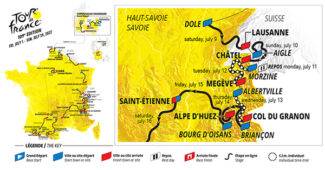
The Natural Gesture: Wine In The Raw
In all things wine, ‘balance’ is the key to the kingdom; it is a term interchangeable with harmony and may reference acid, alcohol level, grape sugars and tannin, but also, to a scale in which the long term health of the product is considered along with the flavors inherent on release. More than just a current radar blip in trendy social capital, a naturalistic approach to winemaking is not only more honest, but better for a sustainable environment: It’s a nod to the past and a gesture to the future.
In wine, ‘natural’ is a concept before it’s a style. It refers to a philosophy; an attitude. It may involve a regimen of rituals or it may be as simple as a gesture, but the goal, in nearly every case, is the purest expression of fruit that a winemaker, working within a given vineyard, can fashion. Not all natural wines are created equal, and some are clearly better than others, but of course, neither is every estate the same, nor is every soil type identical, nor is each individual vigneron’s ideology.
In Savoie, natural wine is increasingly becoming the order of the day. Elevations are such that the mildew that affects vines at sea level is not an issue, and like wines from the Jura were a decade ago, Savoie wines are still considered somewhat geeky and under-the-radar—which makes it an ideal region for innovative winemakers from a younger generation to make their mark.
Mountainous Savoie: Uphill All the Way
The Savoie and the Haute-Savoie have hosted the greatest cycling event in the world 44 times since 1947; 69 ascents have been cleared. In 2021, the cities of Cluses, Tignes, and Albertville welcomed the Tour, and it is said that even the best cyclists need to come equipped with patience and humbleness to reach the Little Saint Bernard Pass at 7,178 feet and to overtake the Col du Galibier 8,668 feet, then hurtle down towards the Hautes-Alpes or catch a glimpse of the Col de l’Iseran sign perched at 9,068 feet, the highest in the region.
After a rest day, Stage 10 of the Tour de France 2022 begins in Morzine, a commune in the Haute-Savoie department and Auvergne-Rhône-Alpes region, a popular stage city appearing for the 22nd time this year. This stage finishes in Megève, a stage town for the third time. Stage 11 enters the heart of one of the greatest cycling climbing areas anywhere, including with two of the most famous bike climbs in the world, Alpe d’Huez and Col du Galibier. Lacets de Montevernier is not as well-known as other climbs in the area, but it is one of the world’s greatest hairpin climbs. Col du Granon in the Hautes-Alpes is a stage finish for the second time.
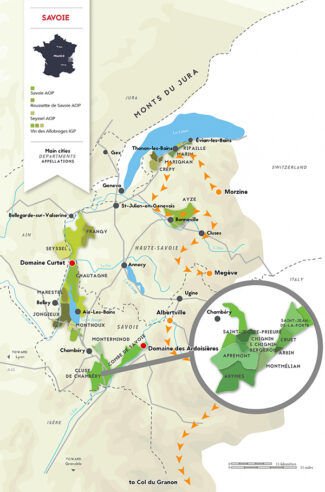
AOP SAVOIE
It’s not possible to be a little bit pregnant, but can you be a little bit Swiss? Savoy says ‘yes’. This impossibly picturesque region just south of Lac Léman (but on the French side of the border) is a fragmented paradise scarcely 5000 acres in total, known for fresh, crisp white wines that often bear a white cross on a red background, the flag of both Switzerland and Savoie.
The terroir of Savoie is typically alpine: Most of the vineyards are planted on steep, south facing slopes where favorable sunlight exposure and excellent drainage make for perfect ripening conditions in spite of the cold continental climate. The region’s myriad mountain ranges offer protection from northwesterly weather systems while the presence of lakes Bourget and Léman (aka Geneva) as well as the upper Rhône River further moderate the climate. Most Savoie vineyards can be found on limestone-based soils, which are adept at storing heat during the day and reflecting it back onto the vines at night. Characteristically, the loose scree soils are thin with little water holding capacity, an important consideration given the relatively high rainfall levels in Savoie. Limited water leads to a reduction in vigor and yield,
Vin de Savoie AOC was created in 1973 along with the Roussette de Savoie appellation that covers the variety Altesse (here called ‘Roussette’) and accounts for some of the region’s most celebrated wines. This is a high-altitude growing area, and three-quarters of the output is white and dry, mostly built around the Altesse, Jacquère (the most widely planted vine) and Chasselas, although in total, 23 grape varieties are permitted. Vin de Savoie wines are often described as being distinctly ‘alpine’, invoking fresh mineral characteristics. Red grapes do not ripen well in the climate, and much of limited production is made from Mondeuse, is an ancient grape variety native to eastern France and associated specifically with Savoie region.
* AOC – Appellation d’Origine Contrôlée – is a French label, while AOP – Appellation d’Origine Protégée – is European Union designation.
The offered 6-bottle package is comprised of one of each of the following wines at $299.
Domaine Marie & Florian Curtet:
Savoie Fare
Undeniably, Marie and Florian Curtet are a dynamic couple, but bringing biodynamics into the relationship has revolutionized their winemaking. After years of apprenticeship, they have succeeded Savoie producer Jacques Maillet and christened those 12 acres on the hillsides above the Upper Rhône ‘Domaine Curtet’. The property consists of two sections. Gamay and Pinot Noir are planted in the commune of Serrieres-en-Chautagne in the lieu-dit Vignes du Seigneur. Nearby, in Motz’s village, the traditional Savoie grape varieties of Mondeuse, Jacquère, and Altesse are grown in the vineyard known locally as Cellier des Pauvres, the Cellar of the Poor.
Like their mentor, the Curtets believe in low intervention, a technique Maillet christened ‘autrement’, or ‘in the other way.’ It consists of farming without pesticides, herbicides or chemical fertilizers, paying close attention to the lunar calendar and using tea and plant extracts to create treatments that naturally protect the vines from diseases and parasites. Winemaking is always done with indigenous yeast and without filtration, and sulfur use is limited to a very small amount at the bottling and only when necessary.
The famous Chautagne ‘molasse’ soils, made of decomposed sandstone, can be found throughout the Curtet’s vineyards, giving an extra freshness to the wines as well as the potential for aging. Reds are whole-bunch macerated and whites are pressed directly.
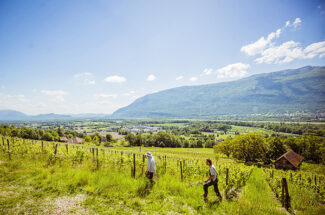
Marie and Florian Curtet, Highness and Jacquère Vines During Summer Season
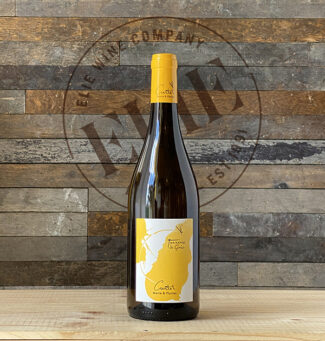 Domaine Marie & Florian Curtet ‘Tonnerre de Grès’, 2019 Savoie White ($43) 11% alc.
Domaine Marie & Florian Curtet ‘Tonnerre de Grès’, 2019 Savoie White ($43) 11% alc.
(50% Jacquère, 50% Altesse) For the uninitiated, Jacquère is a high-yielding alpine variety characterized by an electric acidity often described as ‘mountain fresh.’ The wines tend to be herbaceous with aromas of freshly cut grass, green apples and pears. Highness is a nice counterbalance; slow to ripen, the reddish tinge the berries take on prior to harvest has provided the variety’s chief synonym, Roussette. Prominent descriptors of Altesse include bergamot, hazelnut and almond.
‘Tonnerre de Grès’ shows tart yellow apple, pear, lavender, and bitter unripe nectarine behind flinty sparks. Almond and licorice notes appear as the wine aerates, and the finish gives way to a lingering saltiness stiffened by a focused core of acidity.
*click photo for more info
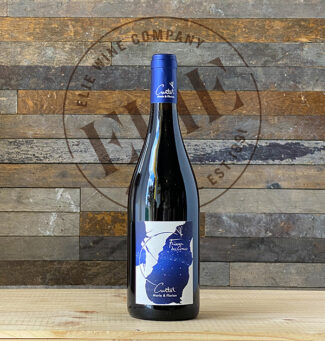 Domaine Marie & Florian Curtet ‘Frisson des Cimes’ Blue Label, 2019 Savoie Rouge ($43) 11% alc.
Domaine Marie & Florian Curtet ‘Frisson des Cimes’ Blue Label, 2019 Savoie Rouge ($43) 11% alc.
(50% Gamay, 40% Mondeuse, 10% Pinot Noir) Gamay was brought to high-altitude Savoie from Beaujolais after the phylloxera epidemic of the 19th century; in the Savoie sub-region of Chautagne it produces bright, fruity, delicious but somewhat lightweight reds. Pinot Noir was imported from Burgundy under the same auspices, and in Savoie, it serves primarily as an earthy blending grape.
Meanwhile, Mondeuse is well on its way to becoming a cult favorite in the red wine world; according to Elie Talaga, the winemaker at Vignoble de la Pierre in Savoie, “The vine tends to be very vigorous, producing many large clusters with big berries. For good concentration, we have to do a green harvest. We cut the clusters to concentrate the grapes leave on the vine.”
‘Frisson des Cimes’ Blue Label is ripe and crisp with a little grapey carbonic showing in the nose. On the palate it is clean and forward with graphite, plum, bitter herbs and a bit of brined fruit on the finish.
*click photo for more info
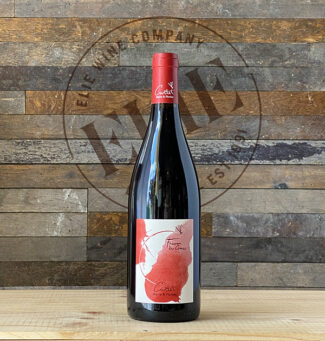 Domaine Marie & Florian Curtet ‘Frisson des Cimes’ Red Label, 2018 Savoie Rouge ($43) 10% alc.
Domaine Marie & Florian Curtet ‘Frisson des Cimes’ Red Label, 2018 Savoie Rouge ($43) 10% alc.
(Mondeuse) From organically-farmed 50 year old vines planted on sandstone slopes with a western to southwestern exposure: In the cellar, whole cluster fermentation takes place without pump-vers or push-downs, lasting 4-5 weeks before the grapes are pressed . The wine then ages in concrete tanks for 11 weeks, filtered lightly, and bottled with just a small dose of SO2.
The wine is dark, with black-purple glints in the glass. Starting off with the pungent aromas of mulch and forest floor, it drifts into black plum, blueberries, pine, kirsch, Kalamata olives, and roasted meat.
*click photo for more info
IGP WINE FROM ALLOBROGES:
First, a word on IGP (Protected Geographical Indication), a European wine classification known in France as Vin de Pays, or ‘country wine’: It’s a fitting translation since it is a category that focuses on geographical origin rather than style and tradition, and gives winemakers greater stylistic freedom than AOP laws. Vin de Pays was introduced in the 1970s, and by the year 2000 there were more than 150 individual VDP titles covering about a quarter of French wine production.
‘Vin des Allobroges’ is an IGP title for red, white and rosé wines from certain parts of Savoie and Haute-Savoie. The Allobroges zone roughly corresponds to the boundaries of the AOPs Vin de Savoie and Roussette de Savoie, along with Seyssel, which just crosses over into the Ain department. Like those AOP titles, Vin des Allobroges wines employ the region’s traditional early-ripening grape varieties to allow for the cooler growing season, and although IGP laws permit the use of slightly different varieties, the core grapes remain the same. Burgundy grape varieties like Aligoté, Chardonnay, Pinot Gris and Pinot Noir are planted alongside the regional specialties Jacquère, Altesse and Mondeuse. Even Poulsard, native of the Jura wine region just to the north, is permitted in the wines, although this is rare. As well as still white,
Domain of Ardoisières:
Ambitious and Original
Beneath the munificent smile of Mont Blanc, Domaine des Ardoisières encompasses 38 steep, terraced acres above the town of Fréterive. The entire production is sourced from two vineyard sites; Cevins and St. Pierre de Soucy. From these climats, winemaker Brice Omont, formerly of Champagne, produces five cuvées, three white and two red.
The domain itself is the culmination of a dream; Michel Grisard came from a winemaking family and studied agriculture, he began with a small plot of Mondeuse in Savoie, but in his travels, discovered the little town of Cévins, which had been left out of the Savoie AOP because the narrow valley receives less sun than other areas and was thought to offer too much challenge in ripening grapes. Grisard saw promise in the derelict vineyards and crumbling stone terraces, which were built on unusual schist soils with steep southerly exposures. Grisard first made the wines under his Prieuré St-Christophe label, but as this unique hillside matured, it became clear that it needed its own identity. The banks would not bankroll an expanded operation, but with winemaker Omont, the funds were raised by local restaurateurs and retailers, who co-signed the loan.
Grisard left winemaking in 2014, and today the Domaine is run by Omont alone, whose patience has paid off: “I take my time,” he says. “You have to let fermentation construct the layers of aromas in the wine. And the wines need time. In the end, it is not complicated. You just have to take care of your grapes.”
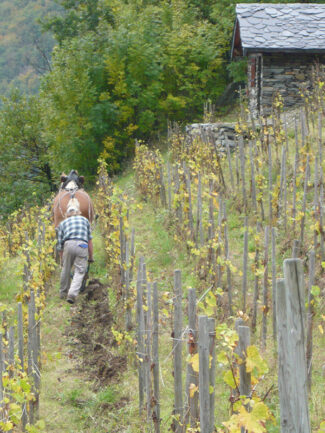
Brice Omont, Domaine des Ardoisières
 Domaine des Ardoisières ‘Argile’, 2020 IGP Wine from Allobroges ‘St-Pierre de Soucy’ White ($34) 11.5% alc.
Domaine des Ardoisières ‘Argile’, 2020 IGP Wine from Allobroges ‘St-Pierre de Soucy’ White ($34) 11.5% alc.
(40% Jacquère, 40% Chardonnay, 20% Mondeuse Blanche) Come to momma! According to DNA, Mondeuse Blanche is Syrah’s mother, with the father vine being Dureza. Worldwide, it is nearing extinction but it retains a foothold in Savoie, where it produces fresh-tasting floral (magnolia blossoms and acacia) wines not notably high in acidity.
Like most Savoie wines, Argile Blanc is a blend of the esoteric and the familiar, showing crisp apple, pear, peach alongside, pineapple, kiwi, butter and lemon cream, leading to a peppery and salty finish.
*click photo for more info
 Domaine des Ardoisières ‘Argile’, 2019 IGP Wine from Allobroges ‘St-Pierre de Soucy’ Red ($43) 11% alc.
Domaine des Ardoisières ‘Argile’, 2019 IGP Wine from Allobroges ‘St-Pierre de Soucy’ Red ($43) 11% alc.
(65% Gamay de Chautagne, 25% Mondeuse, 10% Persan) Gamay does not reach the depths of sumptuousness in Savoie as it does in Cru Beaujolais, but it reflects the unique terroir of Chautagne so admirably that Savoie winemakers trumpet the origins. In Chautagne, Gamay represents half of all grapes grown.
Recent DNA profiling by Jose Vouillamoz have revealed that Savoie’s red darling Mondeuse is related to Syrah, and like Syrah, it displays rich pigmentation and spicy aroma. Nearly all of the world’s supply is grown in Savoie; the same DNA profile proved that most of California’s Mondeuse is actually Refosco dal Pedunculo Rosso.
Persian is enjoying a revival, yet it remains so rare that it was once believed extinct. Tended properly it produces deeply aromatic red wine, but as an early-budding, mid-ripening vine that produces small bunches of tiny berries, it needs to be pruned heavily in order to maintain reasonable yields. The vines thrive particularly well on stony, calcareous soils.
The wine shows a panoply of exotic aromas, including violet blossoms, pomegranate, spicy red forest berries and a mineral-flecked finish.
*click photo for more info
 Domaine des Ardoisières ‘Améthyste’, 2018 IGP Vin de Allobroges ‘Cevins’ Red ($93) 11% alc.
Domaine des Ardoisières ‘Améthyste’, 2018 IGP Vin de Allobroges ‘Cevins’ Red ($93) 11% alc.
(60% Persan, 40% Mondeuse Noire) Persan comes to the forefront in this field blend from the Cévins climat. The name ‘Persan’ has no connection to ‘Persian’, but is instead a corruption of a hamlet’s name in Savoie near Saint-Jean-de-Maurienne which has specialized in the grape since the 17th century.
The Mondeuse Noire used in this blend comes from 50-year-old vines from the Côteau de Cévins, a south-facing terraced vineyard on a vertiginous 60% slope where the soil is derived from metamorphic mica-schists.
In style, the wine is reminiscent of a top Côte-Rôtie from the north of Ampuis where schist also predominates; it shows a similar briary complexity with smoky dark fruit, a touch of pepper and hints of mocha and brown sugar appearing on the finish.
*click photo for more info
- - -
Posted on 2022.07.07 in Savoie, France, Wine-Aid Packages
Featured Wines
- Notebook: A’Boudt Town
- Saturday Sips Wines
- Saturday Sips Review Club
- The Champagne Society
- Wine-Aid Packages
Wine Regions
Grape Varieties
Aglianico, Albarino, Albarín Blanco, Albarín Tinto, Albillo, Aleatico, Arbanne, Aubun, Barbarossa, barbera, Beaune, Biancu Gentile, bourboulenc, Cabernet Franc, Cabernet Sauvignon, Caino, Caladoc, Calvi, Carcajolu-Neru, Carignan, Chablis, Chardonnay, Chasselas, Clairette, Corvina, Cot, Counoise, Erbamat, Ferrol, Fiano, Frappato, Friulano, Fromenteau, Fumin, Garnacha, Gewurztraminer, Godello, Graciano, Grenache, Grolleau, Groppello, Juan Garcia, Lambrusco, Loureira, Macabeo, Macabou, Malvasia, Malvasia Nera, Marsanne, Marselan, Marzemino, Melon de Bourgogne, Merlot, Mondeuse, Montanaccia, Montepulciano, Morescola, Morescono, Moscatell, Muscadelle, Muscat, Natural, Nero d'Avola, Parellada, Patrimonio, Petit Meslier, Petit Verdot, Pineau d'Aunis, Pinot Auxerrois, Pinot Blanc, Pinot Gris, Pinot Meunier, Pinot Noir, Poulsard, Prieto Picudo, Rondinella, Rousanne, Roussanne, Sangiovese, Sauvignon Blanc, Savignin, Semillon, Souson, Sparkling, Sumoll, Sylvaner, Syrah, Tannat, Tempranillo, Trebbiano, Trebbiano Valtenesi, Treixadura, Trousseau, Ugni Blanc, vaccarèse, Verdicchio, Vermentino, Viognier, Viura, Xarel-loWines & Events by Date
- April 2024
- March 2024
- February 2024
- January 2024
- December 2023
- November 2023
- October 2023
- September 2023
- August 2023
- July 2023
- June 2023
- May 2023
- April 2023
- March 2023
- February 2023
- January 2023
- December 2022
- November 2022
- October 2022
- September 2022
- August 2022
- July 2022
- June 2022
- May 2022
- April 2022
- March 2022
- February 2022
- January 2022
- December 2021
- November 2021
- October 2021
- September 2021
- August 2021
- July 2021
- June 2021
- May 2021
- April 2021
- March 2021
- February 2021
- January 2021
- December 2020
- November 2020
- October 2020
- September 2020
- August 2020
- July 2020
- June 2020
- May 2020
- April 2020
- March 2020
- February 2020
- January 2020
- December 2019
- November 2019
- October 2019
- September 2019
- August 2019
- July 2019
- June 2019
- May 2019
- April 2019
- March 2019
- February 2019
- January 2019
- December 2018
- November 2018
- October 2018
- September 2018
- August 2018
- July 2018
- June 2018
- May 2018
- April 2018
- March 2018
- February 2018
- January 2018
- December 2017
- November 2017
- October 2017
- September 2017
- August 2017
- July 2017
- June 2017
- May 2017
- April 2017
- March 2017
- February 2017
- January 2017
- December 2016
- November 2016
- October 2016
- September 2016
- August 2016
- July 2016
- June 2016
- May 2016
- April 2016
- March 2016
- February 2016
- January 2016
- December 2015
- November 2015
- October 2015
- September 2015
- August 2015
- July 2015
- June 2015
- May 2015
- April 2015
- March 2015
- February 2015
- January 2015
- December 2014
- November 2014
- October 2014
- September 2014
- August 2014
- July 2014
- June 2014
- April 2014
- March 2014
- February 2014
- January 2014
- December 2013
- November 2013
- October 2013
- September 2013
- August 2013
- July 2013
- June 2013
- May 2013
- April 2013
- March 2013
- February 2013
- January 2013
- December 2012
- November 2012
- October 2012
- February 2004
Search



